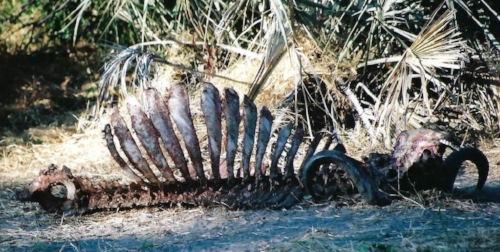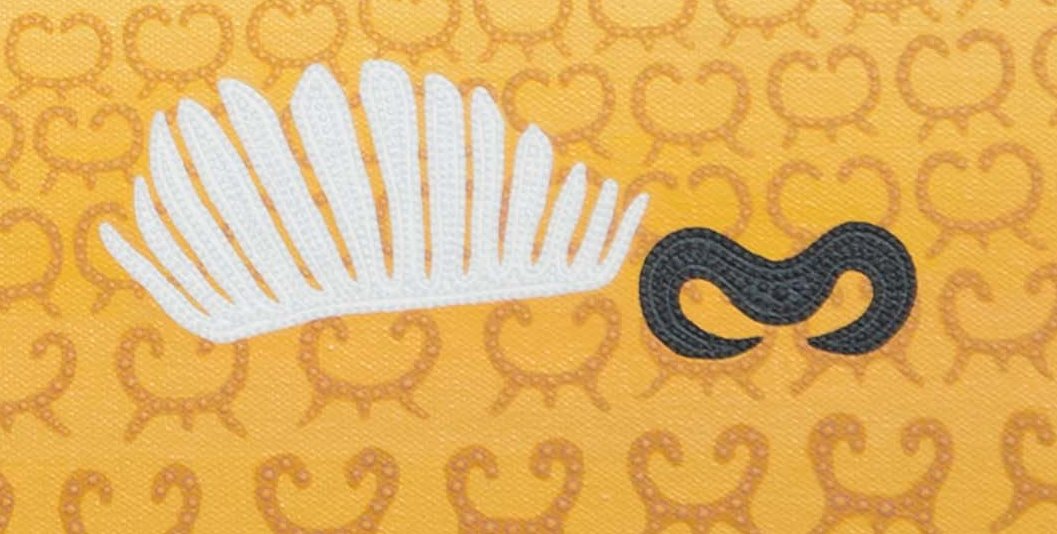As fascinating as our trips to Kenya, Tanzania and Zambia were (discussed in Majestic Africa, Part 1), Botswana was even better. We flew into a more isolated area, and the animal activity was unmatched.
As the baobab trees were a highlight of our earlier African trips, the graceful acacia trees captured our attention in Botswana. Here we are standing in front of one during a mid-morning tea break on one of our game viewing drives.
We had some of our most memorable "Big 5" animal encounters in Botswana. We encountered the massive elephant below (soon to be painted) as we floated along the Chobe River in a small boat in Chobe National Park. He was not pleased as we got closer to the shore, and he came to the water's edge to challenge us. Luckily he decided to stay on shore as we slowly drifted by.
We also had our single most memorable African game experience ever in Botswana. One morning we came upon a group of female lions lying in the grass with a large cape buffalo. This scene was odd since these animals do not hang out together. On closer look we could see that the lions' claws were digging into the buffalo's hide. Suddenly the buffalo wrenched free and stood up, but was immediately attacked again by the lions who dug their teeth and claws into its rear flank and tried to pull it back down. The buffalo fought them off again and again, but each time the lions would attack and the buffalo became more and more exhausted.
After about an hour of this wrestling, a large male lion who had been sleeping nearby got up and, seemingly tired of this ongoing struggle, grabbed the buffalo's throat with a powerful bite and quickly suffocated it. Showing incredible strength, he then flipped the dead buffalo over, tossed it onto the ground and went back to sleep.
As soon as the male left, the female lions started ripping into the dead buffalo's belly. It wasn't long until they were head and shoulders into its entrails.
The kill was heartbreaking, however the aftermath was fascinating. We came back to this scene each morning and night for two more days as the lions continued to feed on the carcass. It was amazing to watch all of the other animals coming to check out the kill. Below is a leopard who haunted the site but never succeeded in challenging the lions. Elephants, baboons, hyenas and other animals also stopped by to see what was going on. With so many animals approaching from all different directions, it seemed like quite the social event.
And of course, more and more vultures flew into the surrounding trees waiting for their turn.
After two full days, the lions finally finished with the carcass and moved on.
Then the vultures moved in. When we stopped by the next day, the carcass had been cleaned down to its bones, horns and teeth and this is what was left.
Chobe Checker
My painting 'Chobe Checker' is a composite of these experiences in Botswana.
The bull elephant we met on the Chobe River is the star of the painting. Similar to my earlier 'Rhino' painting, the elephant is painted using smaller patterns and dots painted within the large dots painted inside larger patterns.
Here is a close-up of the elephant's head showing the patterns and dots painted within the dots of the larger patterns.
Here's another close-up of part of one the elephant's ears.
African symbols are also incorporated into the painting. The Wawa Aba symbol representing strength and toughness is used on the elephant's forehead.
The Pempamsie symbol representing readiness and hardiness is used on the trunk.
A symbol representing edible plants is used as the grasses behind the elephant.
The memory of the cape buffalo that we saw killed, eaten and cleaned down to its bones is honored and represents the cycle of life and death on the savanna.
The beautiful acacia tree is also seen in the background.
All of these memories come together in the 'Chobe Checker' painting. Here he is checking us out.
Birds of a Feather?
Our experiences in Botswana also helped inspire my most recent painting 'Birds of a Feather?'. As seen in the photos above, vultures swarmed the trees all around the carcass of the cape buffalo as the lions fed on it. The photo below with a new vulture flying in to take the top spot on a branch from the others was the initial inspiration for this painting, but my other "inspiration" was the state of the world in 2017.
In 'Birds of a Feather?', there are three vultures lower down on the branch, each with evil reddish eyes under their grey head feathers. None of them are taking any notice of the new arrival. In fact, it seems that they may be making a special effort to ignore him. There's an ominous glow from the world below.
Here's a close-up of one of these vultures.
The new arrival is flapping his wings in self-glorification.
Instead of grey head feathers, his are shades of orange above a cold blue eye. Looking closely, his breast feathers also seem different.
Below is the finished painting 'Birds of a Feather?'.
This painting does not reflect my fond memories of Africa where I have truly had some of my favorite experiences. Unfortunately, it does reflect my mood about the world during 2017. I for one am hoping for much better times in the future and the sooner the better. In this spirit, I promise that my next painting, already in the works, will be more serene and uplifting.























